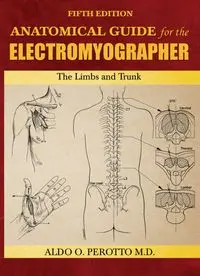
Anatomical Guide for the Electromyographer [Limbs, Trunk] 5th ed. - A. Perotto (C. Thomas, 2011) WW PDF
Preview Anatomical Guide for the Electromyographer [Limbs, Trunk] 5th ed. - A. Perotto (C. Thomas, 2011) WW
ANATOMICAL GUIDE FOR THE ELECTROMYOGRAPHER ANATOMICAL GUIDE FOR THE ELECTROMYOGRAPHER The Limbs and Trunk By EDWARD F. DELAGI, M.D. ALDO O. PEROTTO, M.D. JOHN IAZZETTI, M.D. DANIEL MORRISON, M.D. Fifth Edition by ALDO O. PEROTTO, M.D. Associate Professor Department of Rehabilitation Medicine Albert Einstein College of Medicine Former Director of Residency Training Program New York, New York Illustrated by Phyllis B. Hammond Aldo O. Perotto, M.D. and Hugh Thomas Published and Distributed Throughout the World by CHARLES C THOMAS • PUBLISHER, LTD. 2600 South First Street Springfield, Illinois 62704 This book is protected by copyright. No part of it may be reproduced in any manner without written permission from the publisher. All rights reserved. © 2011 by CHARLES C THOMAS • PUBLISHER, LTD. ISBN 978-0-398-08648-0 (Hard) ISBN 978-0-398-08649-7 (Paper) ISBN 978-0-398-08650-3 (Ebook) Library of Congress Catalog Card Number: 2011001172 First Edition, 1975 Second Edition, 1980 Third Edition, 1994 Fourth Edition, 2005 Fifth Edition, 2011 With THOMAS BOOKS careful attention is given to all details of manufacturing and design. It is the Publisher’s desire to present books that are satisfactory as to their physical qualities and artistic possibilities and appropriate for their particular use. THOMAS BOOKS will be true to those laws of quality that assure a good name and good will. Printed in the United States of America SM-R-3 Library of Congress Cataloging-in-Publication Data Perotto, Aldo. Anatomical guide for the electromyographer : the limbs and trunk / by Edward F. Delagi . . . [et al.] ; illustrated by Phyllis B. Hammond, Aldo O. Perotto, and Hugh Thomas. -- 5th ed. / by Aldo O. Perotto. p. ; cm. ISBN 978-0-398-08648-0 (hard) -- ISBN 978-0-398-08649-7 (pbk.) -- ISBN 978-0-398-08650-3 (ebook) 1. Electromyography. 2. Extremities (Anatomy). 3. Abdomen--Anatomy. I. Delagi, Edward F. II. Title. [DNLM: 1. Electromyography--methods. 2. Extremities--innervation. 3. Muscles--innervation. WE500] RC77.5.A5 2011 2011001172 To the memory of my Mentor and friend Dr. Edward Delagi And to My granddaughter Laura Adriana and to my grandson Martin Alejandro PREFACE T his new edition of the Anatomical Guide for the Electromyographer incorpo- rates updated information concerning the basic principles of elec- tromyography. This edition was written at the suggestion of numerous read- ers who had read the previous edition. Once again, a vast amount of kinesiological information is included that gives this book a functional angle for the reader. The extensive information also provides the electromyographer with a reminder of the functional anato- my that allows him to understand and analyze the electrical findings. Great emphasis is placed on describing the insertion of the needle elec- trode in the intended muscle and to avoid common pitfalls during this phase of the procedure. The technique described for the study of the diaphragm is not based on my own experience, in contrast to the other muscles in this book. The tech- nique for this muscle was described by Doctor P. Saadeh in 1993. See details of the technique in the footnote of the diaphragm muscle. In the Appendix, a drawing of the “Nerves Entrapment in the Upper and Lower Extremities Appendix” has been added to facilitate the use and com- prehension of anatomic and electromyographic knowledge. It is hoped this new edition will help in the development of future generations of elec- tromyographers. A.O.P. BIBLIOGRAPHY Blair, R. et al. (1978). Laryngeal electromyography: Technique and application. Otolaryngology Clinic of North America, 11:225. Hirand, M. et al. (1969). Use of hook-wire electrodes for electromyography of intrinsic laryngeal muscles. Journal of Speech and Hearing Research, 12: 362–373. vii Moore, K. L. (1992). Clinical oriented anatomy (3rd ed.). Philadelphia, PA: Williams & Wilkins. Olson, T. R. (1996). A. D. A. M. Student atlas of anatomy. Philadelphia, PA: Williams & Wilkins. Saadeh, P. B., Crisafulli, C. F., Sosner, J., & Wolf, E. (1993). Needle electromyogra- phy of the diaphragm: A new technique. Muscle and Nerve, 16:15–20. viii Anatomical Guide for the Electromyographer INTRODUCTION T he primary goal of this book is to be able to reach the intended muscle by using simple techniques. Obtaining distances from easily recogniz- able anatomical landmarks are sufficient to acquire the target muscle and this is essential for the interpretation of the electrical findings. The fact that the muscles, especially in the upper and lower extremities are in close proximity to each other, and there is more than one nerve supply- ing the muscles in the limbs, makes this goal extremely important. The prop- er technique for each muscle was obtained after many anatomical dissec- tions. These dissections were performed at the Anatomy Laboratory of the Albert Einstein Collage of Medicine (A.E.C.O.M.) and were shared wit the residents of the Department of Rehabilitation Medicine and the Electrodiag- nostic Laboratory at Jacobi Hospital and at the Albert Einstein Hospital. We arrived at the conclusion that these techniques were very useful. At the suggestion of many readers of previous editions of this book, we have decided to incorporate information that describes the essentials of elec- tromyographic testing. Only needle electromyography will be described. Nerve conduction techniques will not be described because they are consid- ered to be outside the scope of the book. ix
